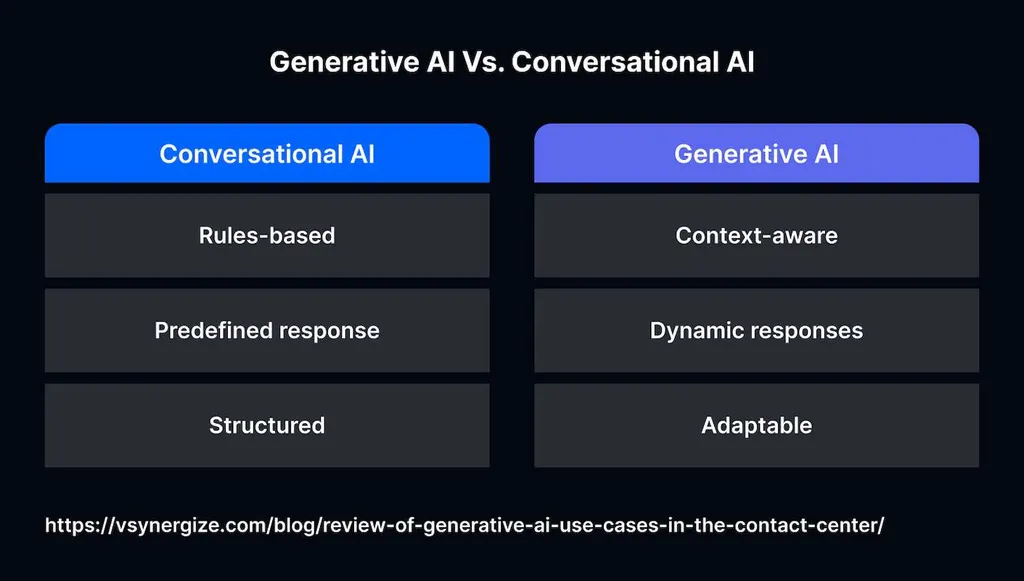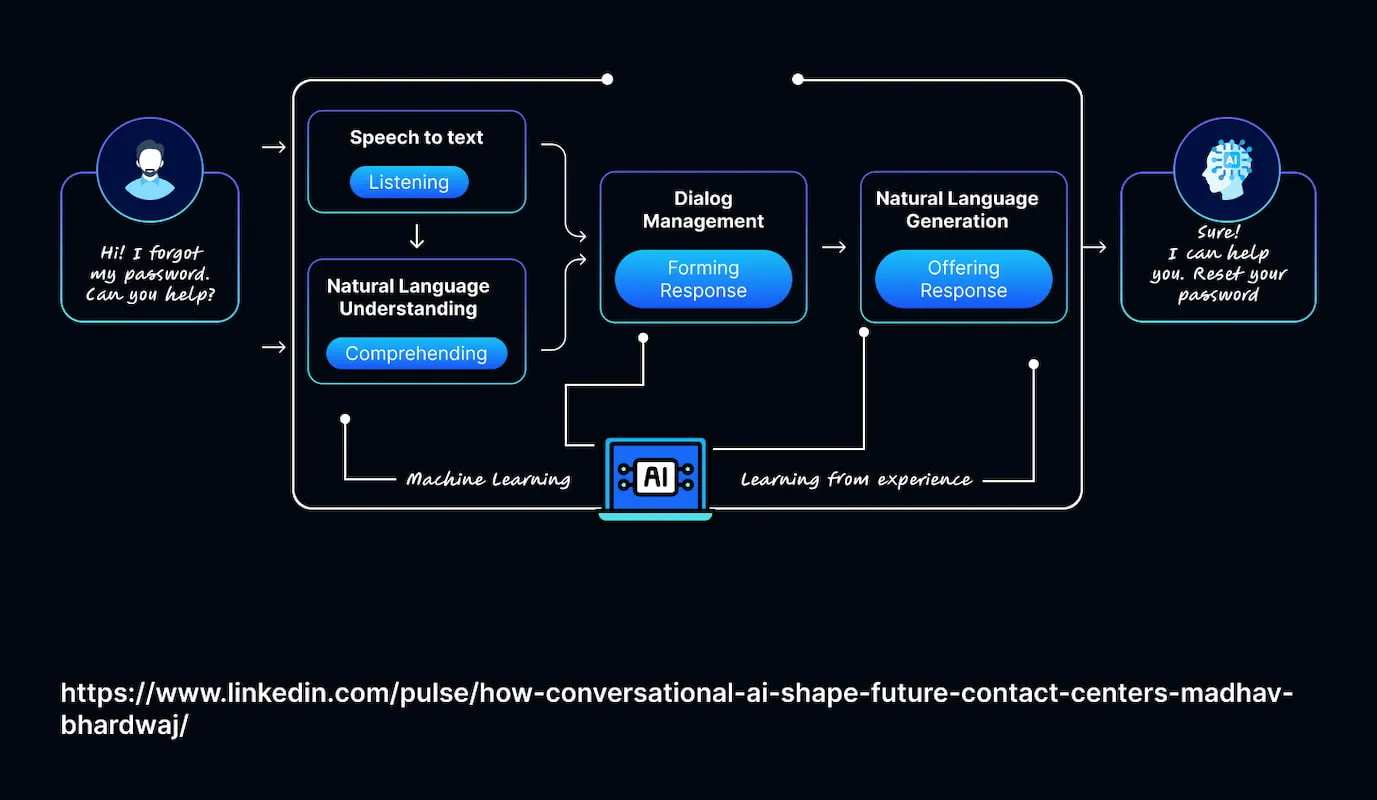By seamlessly integrating Artificial Intelligence (AI) into a customer support workflow, firms provide instant replies to queries to increase engagement, boost profits, and minimize mistakes. Deploying algorithm-based solutions ensures client satisfaction and enables companies to reduce response times. AI-driven services have many applications, from content creation to task automation. Due to the sheer variety of such tools, choosing the right service to improve customer experience (CX) might be an arduous task without comparing conversational AI vs generative AI. In this article, we will consider the main differences between these technologies and investigate whether they can be blended to transform human-machine interaction.
Conversational AI and Generative AI: Definitions

Delving into the world of AI innovations is impossible without clarifying the main terms and outlining their key differences. Conversational AI relies on natural language processing to provide the most relevant response to queries and select the most suitable tone of voice. It facilitates communications between humans and virtual assistants, including chatbots. Here are its core strengths:
- A nuanced understanding of queries;
- Accurate intent detection;
- Replies relevant to the context;
- Personalized responses.
Such models have an intrinsic capacity to learn during conversations and fine-tune their responses. Their deployment proved its efficiency in customer support, marketing, research, and sales. Due to their 24/7 availability and multi-language support, conversational AI bots facilitate order processing and provide instant replies to clients from anywhere.
In contrast, generative AI (genAI) services were designed to facilitate content creation. Solutions leveraging this technology produce visuals, text, audio, and other data types. Utilizing deep learning models, GenAI delivers original professional-level results and seamlessly handles the following tasks:
- Idea generation;
- Content creation;
- Producing summaries;
- Writing and improving code;
- Designing products;
- Adjusting the tone.
The implementation of genAI models brings maximum returns and enables businesses to get a cutting edge, boost their profits, and win clients’ trust.
Besides improving CX, the usage of this technology results in reduced expenses, streamlines troubleshooting, and fosters productivity. Below, we have compared conversational AI vs generative AI to visualize their differences and similarities:
| Criteria | Conversational AI | GenAI |
| Main purpose | Human-like interactions with tailored responses | Content and idea generation |
| Application | Chatbots, shopping assistants, digital helpers | Creating text and media files |
| Training method | Analyzes datasets with the history of past interactions to provide relevant replies | Relies on datasets to master creative content generation |
| Key use cases | Customer support | Produces unique content based on text prompts |
ChatGPT popularized the use of genAI tools and contributed to the success of AI-driven solutions. However, it also highlighted some unresolved issues hindering the adoption:
- Inaccurate replies;
- Unspecified origin of datasets;
- Possible copyright infringement.
Building trust in the power of AI tools necessitates following clear guidelines to ensure regulatory compliance and demonstrate a firm’s dedication to data protection.
How to Enhance CX Leveraging Conversational AI and Generative AI?

Seeking to transform customer experience and establish long-term relationships with clients by increasing their trust in brands, enterprises focus on providing personalized responses to their customers. The role of conversational AI in building complex customer service systems should not be underestimated. Here are the main ways to employ it for maximum efficiency:
- Chatbot integration: Due to their capacity to learn and engage in conversations naturally, anticipating possible questions and providing solutions to unexpected queries, AI assistants have changed the way we engage with brands. Offering assistance 24/7, they masterfully cope with complex tasks and escalate specific cases to human agents when they deem it necessary. Handling multiple conversations simultaneously even during peak times, chatbots refine their responses by analyzing past interactions.
- Implementing interactive voice response (IVR) systems: AI-powered systems detect subtle voice changes and adjust their replies to give them a personal feel. Instead of trying to select a suitable option in a convoluted menu, clients can formulate their questions orally to get an automated response. IVR tools also redirect queries to real agents.
- Analyzing sentiment: Even humans find it a laborious task to pick up subtle differences in the tone of voice and recognize increasing clients’ frustration. Conversational intelligence tools demonstrate high efficiency when it comes to gauging customers’ moods. This capacity allows them to de-escalate the issue by promptly finding a satisfying resolution or delegating the task to a human CS agent.
Generative AI also has the potential to refine CX and maintain a high retention rate. Instead of fully replacing human agents, such tools make their work more efficient. Below, we have outlined the main ways they boost satisfaction:
- Access to knowledge bases: AI tools facilitate learning the information stored in manuals, tutorials, online encyclopedias, and FAQ sections, as they provide easy-to-digest replies with handy tips. Instead of spending valuable time looking for an answer, customers can entrust this task to a digital assistant and get an expertly written reply in a moment.
- Instant feedback: Educating human agents is one of the prerequisites to providing top-notch support. GenAI solutions facilitate evaluating the call quality and offering suggestions on how to boost conversions and ensure regulatory compliance.
- Suggested replies: Providing robotic responses contributes to high client dissatisfaction, so avoiding them is beneficial for improving CX. GenAI analyzes the history of past interactions to avoid repetition and generate the most relevant responses via text chats and voice channels.
Even though GenAI models generate original content with ease, the opponents of the technology emphasize the derivative value of the output. Eliminating biases is also necessary to ensure the adoption of the technology.
Tips for Utilizing Conversational AI and Generative AI
Even though both types of AI have different use cases, companies can use them together to make UX more enjoyable. For instance, AI-powered chatbot integration involves using conversational AI to provide natural replies created with the help of genAI. Trained with the help of a large language model (LLM), conversational AI solutions respond to better quality and ensure the relevance of the content created with the help of genAI.
Recognizing the importance of using these technologies together, you can try to integrate gen AI to improve CX by providing tailored responses. Analyzing feedback, learning how to recognize the signs of possible dissatisfaction, and predicting the development of a conversation are the core strengths of AI-powered services. Models leveraging this technology are used in retail, healthcare, and other industries, where they improve every step of a customer journey.
Final Thoughts
This conversational AI vs generative AI comparison highlights the fact that both of them utilize natural language processing. However, while the former is often used in CS chatbots, the latter is better suited for producing original content. Another difference is that the former is trained with small datasets containing information about past interactions enabling it to provide tailored responses. When used together, these types of AI facilitate generating human-sounding responses to voice and text queries.
At MetaDialog, we recognize the importance of utilizing both technologies when building custom LLM training in accordance with our client’s needs. They facilitate response generation and provide replies relevant to the context. Book our services now and learn how to leverage the key advantages of both technologies.
